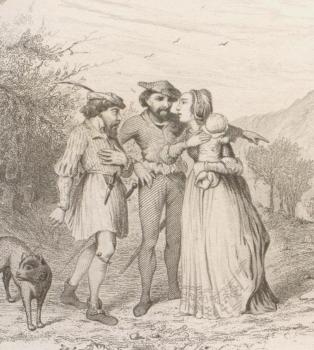31st October 2016
From Thomas Gosselin's Livre des domestiques depuis 1811, in the Library collection.
28th October 2016
From Old Guernsey Exhibition and Fair Souvenir Guide and Programme, St Martin's Parish Hall, Guernsey: T B Banks & Co., 1908, p. 29. The painting of the Queen Charlotte Inn above, a detail of a larger view of Cow Lane, dates from c. 1800; it exists only as a photograph, as its whereabouts since WWII are at present unknown. The colour image is a detail of a painting by Captain C Montague Jones, possibly based up on it, painted 50 years or so later. The original of the Jones watercolour is in the Guille-Allès Library, Guernsey.
1st September 2016
Carteret Priaulx & Co set out the terms and conditions for agents for their privateer the New Daphné, in the Library's MS notebook 'List of privateers and prizes,' perhaps belonging originally to Ferdinand Brock Tupper. The same source lists the Daphne as a lugger captained by A Queripel in 1790, Patrick Harry in 1795, and then by John King. 'Agreed between Messrs C Priaulx & Co. & Messrs Ninian Douglas & John Dadson, the former on the one part acting for the owners of the New Daphné letter of Marque Capt John King bound from this port, to the Earl of St Vincent’s fleet & Gibraltar & the latter, for themselves going out, as Supercargo’s on the above letter of Marque on the voyage stipulated Viz:'
31st August 2016
An Act of the Privy Council concerning jurats, defining a quorum. In 1709, so many of the jurats had had to stand down in a case concerning prizes awarded to the Marlborough privateer that none had been left to judge the case. They had been stood down because they were related to either the plaintiffs or the defendants. This transcription comes from a MS notebook, Lists of privateers and prizes, in the Library collection.
22nd July 2016
Pierre Carey sends a specimen of an unusual tree from Guernsey to Sir Hans Sloane in London, in the hope of advancing medicine. His house, La Brasserie, or the Brewhouse (Carey was head of a very successful enterprise) was finally demolished in 1968. During Carey's lifetime La Brasserie had been home to one of the most splendid gardens in Guernsey.
28th June 2016
In the early 20th century, local historian Edith Carey made copious notes from various manuscripts belonging to the Lukis family into scrapbooks which are now in the Library collection. She collected the following observations about early island archaeology together and copied them again into the notes she made to the book Guernsey Folk Lore, intended to aid her as its editor in a putative new edition, which she never completed. The Lukis family (Frederick Corbin Lukis and his children) were all deeply interested in archaeology, and these journal notes give a very Guernsey flavour of the beginnings of archaeology as a science. The photograph is of 'Frederick Lukis, Esq., at the Du Tus cromlech, Guernsey' from an album in the Library's Harvey collection (the Harvey and Lukis families were related.)
8th June 2016

A translation of an inquest conducted over several months in 1593 by the Colloque, or Assembly, of Bailiwick Churches. The Puritan ministers and elders had here to deal with a dreadful scandal. This piece had a genuine villain: Pierre Le Roy, known as du Bouillon, a church minister who had escaped the massacres of 1572. Formerly minister of the parish of Baron, in Calvados, he was now a refugee, in charge of the parishes of St Pierre-du-Bois and Torteval. The inquiry is full of the detail of the life of ordinary Guernsey people, who gave evidence to the assembly. Michelle Palot, a maidservant to Madame du Bouillon, the minister's wife, was the subject of continued harassment by du Bouillon. Having a baby out of wedlock was highly frowned upon, the mother usually having to do public penance and the father, once ascertained, jailed for a couple of weeks, and forced to marry the mother or at least support the child; but when Michelle was questioned by the authorities as to who had fathered her baby, she gave them a most unexpected answer.
8th June 2016
1593. Pierre du Bouillon's story unravels as witnesses speak out and brave Michelle Palot refuses to waver. The illustrations are from 'Le Cantique de Geneviève de Brabant' and 'Le vieux Château des Ardennes,' in Chants et chansons populaires de la France, Paris: Garnier Frères, 1854, in the Library collection.
15th April 2016
A list of the contents of one of the former Chief Librarian's cuttings books, articles by Durand which he contributed to various publications, concerning his travels in Africa and elsewhere. The photograph above is one of several pasted into the book, and shows an abandoned Boer encampment.
18th February 2016
A rather romanticised article by T Walter Carey, before 1892, probably from the Star newspaper. The photograph above is the one referred to in the article, from the Library Collection (blue cuttings book, Guernsey II, staff.) According to Lenfestey, H, Guernsey Place Names, 2014, this estate actually took its name from Magdeleine Gallienne, the widow of Abraham Lenfestey, in the early 18th century.